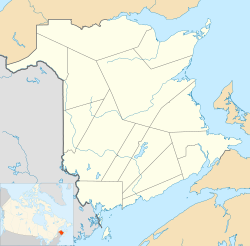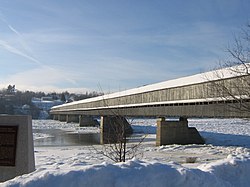Hartland | |
|---|---|
Town | |
 Downtown Hartland | |
| Nickname: Home of the World's Longest Covered Bridge | |
| Coordinates: 46°17′51″N67°31′39″W / 46.29742°N 67.52742°W | |
| Country | Canada |
| Provinces of Canada | New Brunswick |
| County | Carleton County |
| Founded | 1813 |
| Incorporated | October 2, 1918 |
| Government | |
| • Type | Town Council |
| • Mayor | Tracey Demerchant |
| Area | |
| • Land | 9.50 km2 (3.67 sq mi) |
| Elevation | 41 to 103 m (134 to 338 ft) |
| Population (2021) [1] | |
• Total | 933 |
| • Density | 98.2/km2 (254/sq mi) |
| • Change (2016–21) | |
| Time zone | UTC-4 (AST) |
| • Summer (DST) | UTC-3 (ADT) |
| Canadian Postal code | E7P |
| Area code | 506 |
| Telephone Exchange | 375 |
| NTS Map | 21J5 Florenceville |
| GNBC Code | DAJRT [2] |
| Website | http://www.townofhartland.ca |
Hartland is a town in Carleton County, New Brunswick, Canada.
Contents
On 1 January 2023, Hartland annexed all or part of seven local service districts, greatly expanding its area and population. [3] [4] The annexed communities' names remain in official use. [5] Revised census figures have not been released.


